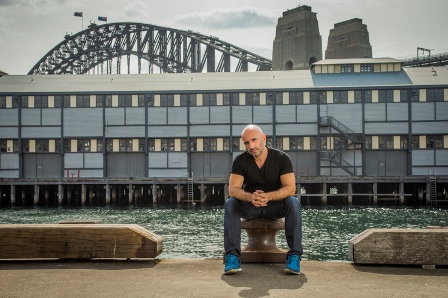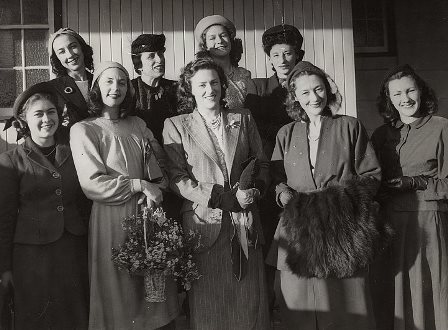- Graduation Ball
In January I received a query via the contact box on this site about some YouTube footage of Graduation Ball. I had never come across this footage before and sadly the vision is of very poor quality. The material has obviously been transferred from format to format on more than one occasion. As for the query, it concerned the date of the footage and eventually I suggested the date of 1947–1949 from the late period of de Basil’s company in the United States. What made me initially feel that it was late 1940s was that I thought I saw, for a flash, Valrene Tweedie as one of the ‘fouetté girls’. In one of the interviews I did with Tweedie I asked her about the roles she had danced in Graduation Ball and she mentioned that she had been one of the ‘fouetté girls’ for de Basil towards the end of her career with him. Watching the footage, I thought I caught a glimpse of a familiar facial expression. Peering hard at the opening credits, I noticed the name Paul Grinwis, and further investigation confirmed that Grinwis had been with de Basil in the late 1940s, which confirmed my initial dating.
Below are links to the two segments of footage. Any further information would be most welcome
- P
Further information about some of the images in the National Library’s Bodenwieser collection has recently come to light. Those close to Bodenwieser recently identified the ‘unknown dancers’ in some of the Library’s digitised images. The most interesting comments concern a photograph of dancers on what has been regarded as a 1950s New Zealand tour. Well this is probably not the case.
The dancers in the image above have been identified as L—R back row: Jean Raymond, Madame Bodenwieser, Pamela Mossman, Dory Stern; L—R front row: Elaine Vallance, Coralie Hinkley, Mardi Watchorn, Eileen Cramer, Denise Searlie. Those who appeared with Bodenwieser around this time say that neither Pamela Mossman nor Denise Searlie performed in New Zealand and that their time with the company was earlier than the date of 1950 given on the record. They believe that the photograph was taken around June 1948 (the weather is cool as suggested by their clothing) and at that time the Bodenwieser Ballet performed in Brisbane and on the north coast of NSW. They suspect the photograph was shot at Brisbane Railway Station. The National Library catalogue record should reflect this new information shortly. [Update September 2020: Sadly, this new information has not been added to the National Library’s catalogue]
- Coming soon
My recent interview with Rafael Bonachela is due to be posted soon on the DanceTabs website. I spoke to Bonachela in mid-January and, as ever, was overwhelmed by the passion and generosity of Sydney Dance Company’s current artistic director. A link to the post is forthcoming. [Update: here is the link].
Michelle Potter, 31 January 2014
Featured image: Rafael Bonachela at Walsh Bay, c. 2014. Photo: © Peter Grieg


Boris Zatouroff worked in France, and made at least one other film of a ballet – Swan Lake in 1949. The copy held by the State Library of New South Wales is recorded in the catalogue as having been made in France in 1949 (no indication as to whether this is the production or release date, but probably the latter). Per the New York State Archives, Globe released the film in the United States in 1950. The New York Public Library copy, which may be the one here, was videotaped from a projected film, and came from the Andre Eglevsky Estate. The NYPL summary states that the film was shot at the Musée des Arts Décoratifs and the Club de Gaulle, Paris – the decor and backgrounds that one can see in the film certainly bear that out.
Thank you David. As ever your comments make perfect sense. I have looked up Kathrine Sorley Walker’s De Basil’s Ballets Russes, which of course I should have done before posting. She has an interesting paragraph or two on the filming on page 153. A couple of sentences stand out and are certainly to the point. She writes: ‘Like most film directors, Zatourov had his own ideas about filming ballet and knew little about dance and dancers…Scenes were taken from extraordinary angles, even from behind, entrances were altered and there was no room to dance properly’.
As for thinking Valrene was one of the ‘fouetté girls’, I think that was simply wishful thinking. As far as I know she was never in Paris in the 1940s.
KSW gives the filming date as 1949.
I know that the quality of the film is such that, at times, it’s like looking at something in a blizzard, but what I could see I thought quite lively and charming, so it was interesting to read the comments by Sorley Walker about the actual filming. I don’t suppose there’s any doubt that a ballet is incredibly hard to film successfully, if only because a ballet is designed to be seen from the front, so to speak. What I really enjoy about your posts, Michelle, is that it’s like being on a treasure hunt of the very best kind.
Thanks David. So pleased you enjoy my posts. I am interested to know about the building at the beginning of the film. I wonder if it is the Club de Gaulle, about which I can find nothing on first try?
On the subject of the treasure hunt, the hunt occasionally reveals some amazing treasures. I have just received a comment on a post I wrote some time ago now regarding Nina Verchinina. What a surprise it was. Here is the link to the comment. I remember reading an article, also some time ago, entitled ‘The chase, the capture’. Well what a lovely capture in the Verchinina comment.
I’ve posted something on that particular article, as Verchinina was one of the dancers that Haskell so much admired and in my youth his ‘Balletomania’ was my bible (and really is the book that set me off on my own discoveries about ballet and its history). Regarding the Club de Gaulle – it’s completely stumped me, too, so far. I am working on the premise that either it’s a mistake, and that the filming took place at one of the premises of, say, the Jockey Club or the Cercle Interallie, or that a long-standing social or political club was re-named in de Gaulle’s honour. So, I’m comparing the interior shots in the film with various photographs of some of the grand Paris clubs – I’ll let you know if anything comes up.